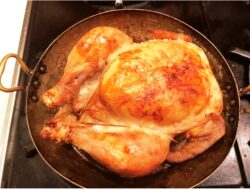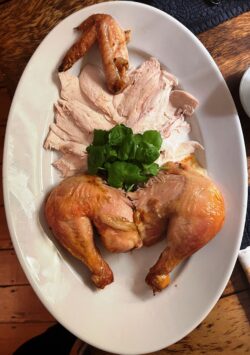Read Time: 4 Minutes Subscribe & Share
The RWM Cooks
 It’s time. I have alluded to the RWM (Resident Wine Maniac) and his obsession with hunting down wines but have not given him the credit he deserves for a handful of dishes he makes really well. One is his roast chicken. We are not talking about the somewhat suspect rotisserie chickens found at your friendly grocery store for equally suspect prices. His technique is based on a recipe that Patricia Wells attributes to L’Ami Louis in Paris, France.
It’s time. I have alluded to the RWM (Resident Wine Maniac) and his obsession with hunting down wines but have not given him the credit he deserves for a handful of dishes he makes really well. One is his roast chicken. We are not talking about the somewhat suspect rotisserie chickens found at your friendly grocery store for equally suspect prices. His technique is based on a recipe that Patricia Wells attributes to L’Ami Louis in Paris, France.
The fact that Patricia Wells attributes it to L’Ami Louis gives one pause. This 12-seat historic bistro, which has a fawning review from the Goop founder and stinging rebukes from other lesser known food and travel acolytes, has always made me avoid trying to get a reservation. Reviews by the restaurant’s unfortunate clients chowing down on $100 chickens and $40 asparagus spears abound. Perhaps my favorite is by A.A. Gill, who along with Seymour Britchky knew how to turn a scathing phrase or two.
But back to a great roast chicken. When done right, you’ll have a lovely meal (potatoes with the sauce, salad on the side). You might have enough for a couple of delicious chicken sandwiches if it’s just feeding two. And don’t throw away the carcass until you have made chicken stock. If you are mildly ambitious, you can clarify it. which I think is fun. The recipe is one of many gems included in Bistro Cooking (sadly AOOP*) and has been tweaked by the other person in this house to the point where I no longer try to roast chickens myself. In a person-to -person interview on his success, he gave the following pointers.
Tweaks & Details
Buy an organic chicken – even with the weakened USFDA organic regulations, it is going to be better for you than the industrially raised ones. You want a chicken that weighs no more than approximately 3.5lbs or 1.5kg. Really, a larger chicken will not give you as succulent a roast. You should truss the chicken. We have roasted chickens with and without trussing, and the improved juiciness with trussing is undeniable. If after watching this video, it still seems too complicated, at least tie the legs together.
Leave the gizzard, heart and liver (but remove the wrapping) inside the chicken if available.
Rub duck or goose fat on the trussed bird, if you can get either. If not available, use softened butter. In fact, RWM usually adds a couple of additional tablespoons of butter to help create a basting sauce. Basting is important. The two poultry fats make for a more golden chicken skin; but if neither is available, salted or unsalted butter is lovely, and is what Patricia Wells recommends.
 He puts the bird in breast side up in a battered round copper gratin that is just large enough to hold the chicken. If the pan is too big, the juices you need for the sauce will evaporate. Also, turn the pan around mid-roasting, because usually the back of your oven is hotter than the front. The frequent basting recommended in the recipe is important. He starts his basting after 20 minutes.
He puts the bird in breast side up in a battered round copper gratin that is just large enough to hold the chicken. If the pan is too big, the juices you need for the sauce will evaporate. Also, turn the pan around mid-roasting, because usually the back of your oven is hotter than the front. The frequent basting recommended in the recipe is important. He starts his basting after 20 minutes.
Neither of us can tell when a roast hits the proper temperature by look or touch. He too uses a Thermapen to test for doneness. – we look for about 165F on the breast and a bit less when you test it between the breast and legs. It should be done in about an hour or so. He then rests it on a cutting board while he makes the sauce You can cut off the two thighs and legs if you want to speed up the cooling process, but a resting time makes for nicer breast slices. Always steel your knife before carving the breast meat, and you will be rewarded with smooth, non-shredded slices.
Pick the chicken up with two forks so that the juices can drain from the cavity into the pan. Pour this elixir into a glass and wait briefly for the fat to separate from the juice. Pour or skim off about half the fat (the top liquid layer in the glass) and pour the rest back in the roasting pan to make the sauce as directed in the recipe. He reserves this sauce in a pitcher or gravy boat rather than pouring it over the carved. chicken. His favorite accompaniments are American style fluffy mashed potatoes (not the thinner European potato puree) and skinny French string beans. The RWM has a signature design for serving this divine roast chicken, which always makes me laugh before I dive in. He did ask me to mention that he prefers Chablis with a dish that he clearly has made his own.
this elixir into a glass and wait briefly for the fat to separate from the juice. Pour or skim off about half the fat (the top liquid layer in the glass) and pour the rest back in the roasting pan to make the sauce as directed in the recipe. He reserves this sauce in a pitcher or gravy boat rather than pouring it over the carved. chicken. His favorite accompaniments are American style fluffy mashed potatoes (not the thinner European potato puree) and skinny French string beans. The RWM has a signature design for serving this divine roast chicken, which always makes me laugh before I dive in. He did ask me to mention that he prefers Chablis with a dish that he clearly has made his own.
*Alas Out Of Print
- 1 whole roasting chicken (3 to 4lbs or 1.5 to 2kg), well rinsed and patted dry at room temperature
- 1 tablespoon 15gr goose fat, duck fat or failing that, substitute butter
- Sea Salt
- 4 tablespoons (60gr) unsalted butter
- 1 bunch fresh watercress
- Preheat the oven to 425F (320C)
- Place the liver, gizzard, heart, neck inside the cavity of the chicken.
- Truss with household string
- Place the chicken in a roasting pan just large enough to hold it.
- Rub the chicken all over with the poultry fat and season with salt.
- Place the roasting pan in the center of the oven.
- Roast, basting every 10 minutes or so to ensure even browning without drying out — until the juices run clear when the thigh is pierced with a fork - about 1 1/2 hours for a 4lb (2kg) chicken.
- Remove the chicken from the oven.
- Pour any juices from the chicken cavity into the roasting pan.
- Allow the chicken to rest for 10 minutes before carving
- Meanwhile, add the butter and 3 tablespoons of water and deglaze the pan over high heat, scraping up any caramelized bits of skin that stick to the pan.
- Cook until the liquid is reduced to a syrup , 2 to 3 minutes.
- Carve the chicken and place the pieces on a warmed platter.
- Pour the sauce over the chicken.
- Arrange the watercress around the chicken pieces and serve immediately.

Kitchen Detail shares under the radar recipes, explores the art of cooking, the stories behind food, and the tools that bring it all together, while uncovering the social, political, and environmental truths that shape our culinary world.




If you’re using a thermopen, then you can cook to about 154 and if you maintain that temperature for 4 minutes, you’ve pasteurized the meat; makes a huge difference!
Hello Mark,
I am really glad that you wrote this. I had read it but never had used that formula but plan to now!
Patricia Wells’ Bistrot Cooking is one of my favorite cookbooks. I’ve had it for years and still use it regularly.
Hello Lorna,
We used our first copy so much that some of the pages started falling out, and Victoria Sackett, the KD editor bought us another. She said she had too many good dinners out of it at our house, she did not want us to be without a copy!
Nancy
Looks delectable. I recall your telling me that he also makes exceptional scrambled eggs. Recipe or technique please?
Hi Carol,
I will have to ask Robert and try my hand at making a video. Stay tuned!
Nancy
Thank you Nancy and RWM for these incredible tips. A simple roasted chicken is one of my favorite things to make, and your tips will certainly take my game up a notch. Love the newsletter, keep them coming!
Hi Sherry, let me know how your chicken turns out. Robert has loved all these comments on “his” roast chicken!
Nancy
I love this recipe and use it all the time. I even truss the bird, which I never did before reading Nancy’s piece (and watching the video about 15 times). This evening grandchild #4 ate chicken (2 helpings!!) for the first time. High praise in our family.
Thank you Nancy for continuing to write, sharing your life in Italy, and generally staying in touch.
Pat,
I read your email to the RWM (Robert to me) and he was just thrilled! I have had lots of roast chicken and even though I would never spend the money to have it at L’Ami Louis, plus the aggravation of being patronized, at best, the recipe is just outstanding. Thank you for letting me know!
Nancy